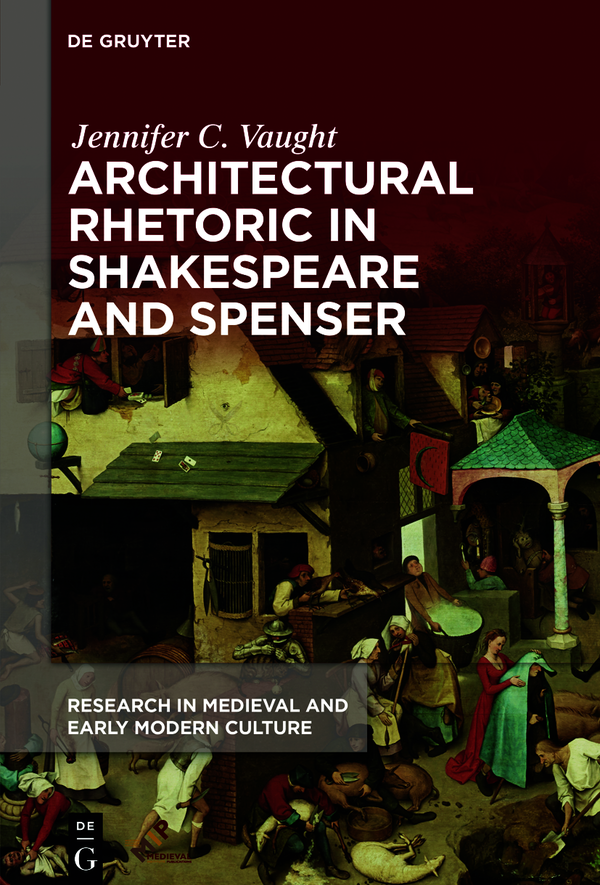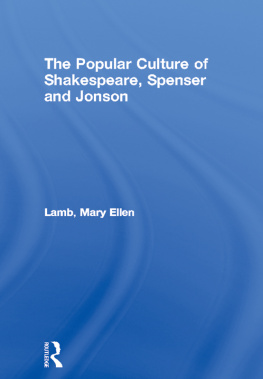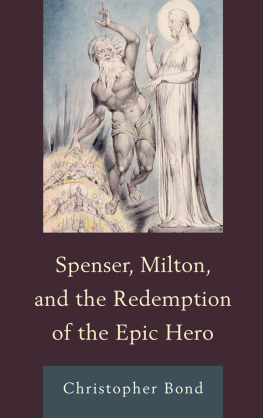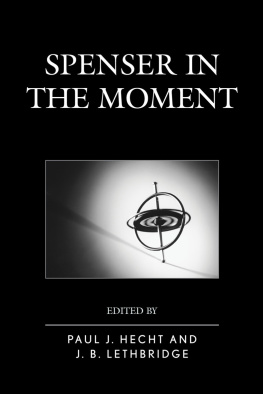Vaught Jennifer C. - Architectural Rhetoric in Shakespeare and Spenser
Here you can read online Vaught Jennifer C. - Architectural Rhetoric in Shakespeare and Spenser full text of the book (entire story) in english for free. Download pdf and epub, get meaning, cover and reviews about this ebook. year: 2019, publisher: De Gruyter, genre: Romance novel. Description of the work, (preface) as well as reviews are available. Best literature library LitArk.com created for fans of good reading and offers a wide selection of genres:
Romance novel
Science fiction
Adventure
Detective
Science
History
Home and family
Prose
Art
Politics
Computer
Non-fiction
Religion
Business
Children
Humor
Choose a favorite category and find really read worthwhile books. Enjoy immersion in the world of imagination, feel the emotions of the characters or learn something new for yourself, make an fascinating discovery.

- Book:Architectural Rhetoric in Shakespeare and Spenser
- Author:
- Publisher:De Gruyter
- Genre:
- Year:2019
- Rating:3 / 5
- Favourites:Add to favourites
- Your mark:
- 60
- 1
- 2
- 3
- 4
- 5
Architectural Rhetoric in Shakespeare and Spenser: summary, description and annotation
We offer to read an annotation, description, summary or preface (depends on what the author of the book "Architectural Rhetoric in Shakespeare and Spenser" wrote himself). If you haven't found the necessary information about the book — write in the comments, we will try to find it.
Architectural Rhetoric in Shakespeare and Spenser — read online for free the complete book (whole text) full work
Below is the text of the book, divided by pages. System saving the place of the last page read, allows you to conveniently read the book "Architectural Rhetoric in Shakespeare and Spenser" online for free, without having to search again every time where you left off. Put a bookmark, and you can go to the page where you finished reading at any time.
Font size:
Interval:
Bookmark:

Research in Medieval and Early Modern Culture
ISBN 9781501517938
e-ISBN (PDF) 9781501513152
e-ISBN (EPUB) 9781501513091
Bibliographic information published by the Deutsche Nationalbibliothek
The Deutsche Nationalbibliothek lists this publication in the Deutsche Nationalbibliografie; detailed bibliographic data are available on the Internet at http://dnb.dnb.de.
2019 Walter de Gruyter GmbH, Berlin/Boston
For Judith
First and foremost, I am grateful to Medieval Institute Publications of Western Michigan University for their initial interest in this project. Erika Gaffney, Senior Acquisitions Editor in Early Modern Studies for MIP, has provided expert advice and guidance.
Since 2012 I have presented earlier versions of parts of this book at meetings of the Shakespeare Association of America and at the Sixteenth Century Society and Conference. SAA seminar directors who have helped develop my thinking about architectural rhetoric by building a forum for lively discussion about a common topic and for written commentary on seminar members work are Tamara Goeglein and Frederick Kiefer in Visual Studies and Early Modern Drama; Lauren Shohet in Forms of Time; Julie Sanders and Garrett A. Sullivan in Landscape, Space and Place in Early Modern Literature; Edel Lamb and Fiona Ritchie in Shakespeare and Riot; Marjorie Rubright in Terrestrial Shakespeare; and Andrew Griffin and James Kearney in Shakespearean Negativity. I greatly appreciate the thoughtful and inspiring responses to my work on Spenser and Shakespeare by a number of individuals. These astute readers and commentators include Judith Anderson, Chris Barrett, James Ellis, Carol Ann Johnston, Naomi Conn Liebler, Daniel Lockman, Marianne Montgomery, and Geraldo U. de Sousa. I thank Sean Keilen and Nick Moschovakis for including my essay The Ciceronian Mnemonic and Shakespeares History Plays in their collection, The Ashgate Research Companion to Shakespeare and Classical Literature. Chapter 2 of this book includes a revised version of that piece.
Financial assistance for travel to academic conferences and to the Pennsylvania State University Library for research was generously provided by the English Department and the College of Liberal Arts at the University of Louisiana at Lafayette and by donors for the Jean-Jacques and Aurore Labb Fournet / Louisiana Board of Regents Professorship in English. Two semester-long sabbaticals in 2012 and 2016 were critical for the sustained development of this project and its completion. I give special thanks to Professor Dayana Stetco, Chair of the English Department, and Jordan Kellman, Dean of the College of Liberal Arts, for leading through creative and scholarly example and for their management of day-to-day academic matters essential for faculty research and teaching.
My work on the idea of the body as a house grew out of the collection of essays I edited entitled Rhetorics of Bodily Disease and Health in Medieval and Early Modern England (2010) for Ashgate with Erika Gaffney as Commissioning Editor in Literary Studies. The cover image for that edited volume features an engraving from the scientific and medical textbook Maaseh Toviyan (1707) by physician Tobias Cohen that juxtaposes the anatomy of a man with corresponding exterior and interior features of a house. This group of essays about the rhetoric of the body begins with an essay by Elisabeth Lisi Oliver and Maria Mahoney, Episcopal Anatomies of the Early Middle Ages. Their work on corporeal metaphors, analogies, and allegories led to my exploration of architectural rhetoric for the body and mind in Shakespeare and Spenser.
I owe a great deal of thanks to numerous teachers and scholars who have helped me immeasurably over the years. In 1996 Joan Pong Linton, as a member of my dissertation committee chaired by Judith Anderson at Indiana University, encouraged me to pursue my interest in early modern architecture; she has continued to provide support as Ive deepened my knowledge of Renaissance literature, rhetoric, and architecture. I rely on the comradery of a troupe of Spenser and Sidney scholars who make a pilgrimage each year in May to Kalamazoo, Michigan for the International Congress on Medieval Studies at Western Michigan University. For their fellowship and passionate dedication to sixteenth century studies, I am truly thankful. I am particularly indebted to David Wilson-Okamura, Sean Henry, Rachel Hile, Susannah Monta, and Brad Tuggle, members of the Spenser at Kalamazoo Organizing Committee with whom Ive worked since 2009. I also thank Bill Oram, Anne Lake Prescott, and Susannah Monta for their invaluable contributions to the journal Spenser Studies.
Colleagues and friends have produced a vitally energetic and convivial environment in which to teach and write. In 2016 Michael Kightley, Elizabeth Bobo, Chris Healy, Leah Orr, Robin Hermann, Monica Wright, and I created an undergraduate minor in Medieval and Early Modern Studies for the College of Liberal Arts at the University of Louisiana at Lafayette. This minor crosses boundaries between the disciplines of literature, history, philosophy, and architecture during the medieval and early modern time periods. I am grateful for friendships with my early Americanist colleagues Monica Busby and Laurel Ryan, who exhibit keen medieval sympathies and Transatlantic expertise. I thank Lisa Graley and Taylor Clement for thought-provoking conversations about a variety of topics, including the besieged castle in Renaissance literature, while I bike and they run in a nearby neighborhood where we often meet. My next-door neighbors Ken, Julie, Collin, and Elizabeth Miller have made our street in Lafayette, Louisiana feel very much like home, despite it being far from my extended family in State College, Pennsylvania. I am thankful for the love, support, and encouragement I receive from my mother, Janie Daggett Vaught; my sister, Cheryl Vaught Hile; and my three nieces, Lauren, Kristi, and Becca, and brother-in-law, Steve. Milton and Max, snoring in their dog beds at my feet while Ive sat at my office desk writing this book, have given daily creature comforts.
My husband, Will Emblom, provides the foundation for my creative and scholarly pursuits. I am deeply grateful to him for being there from the beginning to the end of this project. This book is dedicated to Judith Anderson, my teacher at Indiana University who first introduced me to the highly addictive pleasure of reading Spenser well and my treasured friend for over twenty-five years. Her outstanding scholarship on Spenser and Shakespeare acts as the cornerstone for this book, my own castle in the air.
If you have built castles in the air, your work need not be lost; that is where they should be. Now put the foundations under them.
Henry David Thoreau, Walden
William Shakespeare and Edmund Spenser shared a mutual interest in architecture, real and imagined.1 They walked some of the same streets in London, and they were familiar with the commonplace of the body as a fortified, yet penetrable structure found in numerous works from classical antiquity, the Middle Ages, and the Renaissance. As a result, both writers in their plays and poems represent the body and mind in figurative terms of a besieged castle or house; a walled city vulnerable to ruin; or as another dwelling surrounded by the elements of earth, air, fire, or water, which Galen links to the four bodily humors. The Castle of Alma in Book II of Spensers Faerie Queene is a widely recognized example of a Renaissance literary structure with ties to medieval architectural allegory, exemplified by the Castle of Unity in
Font size:
Interval:
Bookmark:
Similar books «Architectural Rhetoric in Shakespeare and Spenser»
Look at similar books to Architectural Rhetoric in Shakespeare and Spenser. We have selected literature similar in name and meaning in the hope of providing readers with more options to find new, interesting, not yet read works.
Discussion, reviews of the book Architectural Rhetoric in Shakespeare and Spenser and just readers' own opinions. Leave your comments, write what you think about the work, its meaning or the main characters. Specify what exactly you liked and what you didn't like, and why you think so.









